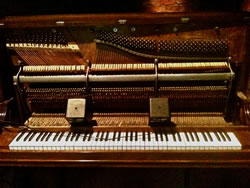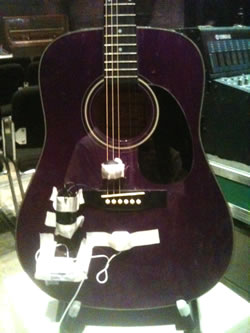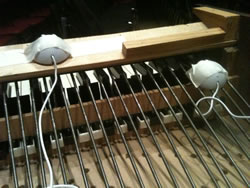Resounding but Not Sounding
Diffusing into interior spaces of instruments
The acousmatic listening situation presents a unique decoupling of sound production and produced sound, of physical gesture and aural gesture. While conventional acousmatic concert diffusion aims to provide a “neutral” and “invisible” reproduction of sound, the reintroduction of sound-producing objects and instruments in a concert setting can afford a fascinating perceptual blurring of sound and source, as well as new possibilities for investigating space and spatialisation.
Much of my recent work has involved the diffusion of electroacoustic sound into loudspeakers placed inside of or onto musical instruments. To illustrate this practice, I will present several recent mixed and acousmatic works and some of the conceptual and compositional issues emerging from them.
Objects-Interiors — Diffusion inside a Piano
In Objects-Interiors (2013), two loudspeakers are placed in the interior of a piano. The sustain pedal is held depressed with weights, and the resonant interior of the piano-as-space and the sympathetic vibrations of its strings contribute to an acoustic “tincturing” of the sound. In most performance contexts, a grand piano is used; one speaker points toward the audience and the other toward the lid of the piano, which subsequently reflects the signal — slightly delayed — in the direction of the audience.

Objects-Interiors uses impulse responses recorded in various spaces as a primary source material. Impulse responses are typically used as signals in convolution reverb, where a brief burst of noise recorded in a reverberant space (produced acoustically by a starter pistol, a balloon or even a hand-clap; or produced synthetically with speakers and noise generators or sine sweeps) is convolved with another signal to amplify the frequencies that are emphasised by the impulse over time. In this work, I treated the impulses as musical materials in an attempt to work with the colours of space directly. Many of the impulses were recorded in different kinds of large spaces (cathedrals, auditoriums), extending the quality of the piano’s interior space beyond its intimate walls. However, many of the impulses in the piece were recorded inside of a piano with a balloon. Played back, they reinforce its acoustic character in a kind of aural redundancy, almost as an acoustic analogue to auto-convolution (where a signal is convolved with itself); playing back a piano’s impulse response inside of itself creates a hyper-reinforcement of its resonant properties.
Another primary source material in Objects-Interiors is found in the incidental sounds of piano performance, such as chairs squeaking, the moving of the lid, activation of the pedals. These sounds potentially recontextualise the piano as a subject of depiction, rather than treating it as an abstract music-producing device devoid of cultural reference and quotidian physical presence. Essentially categorising the instrument as a kind of furniture, these sounds may further frame the piano as an interior space. Another important function of these sounds’ inclusion (and the occasional more “traditional” musical sound from the piano’s keys or strings) is to provide a pillar of reference for the piano as a space with sounds “indigenous” to it (Audio 1). Other sounds also (and other qualities of space) appear and “pianify” exterior sounds and environments. And so we have a continuum of sounds drawn along the line of their source — played back in the piano through loudspeakers. They may be familiar, expected sounds, or sounds that contradict the instrument’s identity and objecthood.
“Bodies-Soundings” — Diffusion through Acoustic Guitar and Toy Piano


Bodies-Soundings (2014) acts as a kind of “sequel” to Objects-Interiors. In this work, the sound is partially diffused through tactile transducers attached to an acoustic guitar (Fig. 2) and toy piano (Fig. 3). Transducers are essentially speakers in their most basic state, without cones or enclosures; the instruments to which they are attached act in place of speaker cones, amplifying the sound according to their own resonant properties (emphasising some frequencies, attenuating others).
Following our “acoustic convolution” metaphor, we may see transducer diffusion as similar to convolution, where the pressure delivered through the transducers activates something like an impulse response in the instruments. Again in this piece, the idea of redundancy becomes important, and also more acoustically salient. While the enclosed speakers in Objects-Interiors interact with the space of the piano, in Bodies-Soundings the instruments act as the speakers themselves. And so, sounds sourced from those instruments are additionally amplified when played back “in their home”, as those frequencies resounding are precisely those reinforced by the instruments.
Furthermore, the direct contact with vibrations from the transducers can induce additional acoustic responses not present in the electroacoustic signal played through them. In particular, depending on the transducers used and their placement on the instruments, lower frequencies can cause the instruments to shake or the movement of the transducer against the instrument to produce a new acoustic response. Often in performances of these pieces I have placed one transducer on the guitar strings and another on the metal rods of the toy piano — if discrete diffusion is available, the acoustic responses afforded by these placements allow a performative activation of the instruments’ sounding structures.
Because of this very physical engagement with the instruments, many of the sound sources in Bodies-Soundings attempt to highlight the physical construction of the instruments — creaks of wood, manipulations with hands or rubber ball mallets against the wood and metal of the instruments, emphasising their building materials (Audio 2). Other more “organic” sound sources (from breath, twigs snapping, celery being ripped apart) further this anthropomorphic idea, imagining the sounding bodies as physical bodies.
“IF:IFF” — Interaction with Live Musicians
The preceding two works discussed are both “extended acousmatic” works in the sense that there are no performers producing the sounds live, only activation through the instruments and loudspeakers. IF:IFF (2014) engages this idea with live performance, where instruments with interior speakers are mixed with live musicians playing instruments. In this work, an acoustic guitar (without a performer) joins the ensemble and amplifies sound through an attached transducer, while a piano (with a performer) has a hidden speaker placed inside its frame. In this way, the work engages two performative modalities of instrument diffusion: one where the instrument is entirely “disembodied” (the guitar) and one where the act of sound production is blurred (the piano), as it can resound from the speaker inside of it, but also sound directly when the performer plays.
Because of its context within a large chamber ensemble (14 musicians), the sounds produced electroacoustically through the instrument-speakers are contextualised by a predominantly instrumental sound identity. And so, an important concern of the work is blurring instrumental sound sources from their physical cause, both through the severance of this link (sound produced through the instruments with no physical activation) and by mismatching sound-identities with physical gesture (Audio 3). For instance, there is a moment in the work where the piano produces guitar sounds and vice versa. Similarly, the interaction with the live performer at the piano allows “extended” performance gestures where the sound resonating in the piano is much greater than the pianist can produce (while still seeming “piano-like”).
Other aspects of the piece examine the idea of “cause and effect” in general. Near the end of the piece, the musicians mime their parts while the loudspeakers play a recording of their previous performance, gradually processed electronically to sever the illusion. A central image of the work is the percussionist’s miming of striking a suspended pane of glass with a hammer. This occurs several times during the work, but the work closes where this physical gesture is finally synchronised with an actual recording of glass shattering.
Acoustic Taxidermy — Installation Context
In the previously discussed works, I have been interested in the performative engagement with instrument-diffusion, where the concert setting affords a kind of listener expectation and attention that can heighten the perceptual blurring the pieces examine. However, the idea is applicable in a gallery context as well, and the kind of listener engagement in the context of an installation can allow a closer scrutinisation of the phenomenon. Acoustic Taxidermy: Guitar Quartet (2014) features four wall-mounted acoustic guitars, each activated with a transducer. The sounds are triggered by a stochastic software environment, treating the guitars as a kind of acoustic “ecosystem” where each guitar produces sound independently, but as part of a carefully tuned niche in its larger context. This work in particular emphasises the acoustic vibrations caused by low sine tones, causing rattling of the transducers against the bodies of the instruments.
Objecthood and Causality
An initial consideration in all of these works is that of objecthood. In electroacoustic music, we have the familiar concept of the “sound object” proposed by Pierre Schaeffer (1966, 95). He defines the term antithetically, stating that “the sound object is not the instrument that has played” (Ibid., translation mine). However, by disrupting the acousmatic listening situation (where there is no physical antecedent cause for a sound, besides a loudspeaker) through drawing attention to an associated physical object (in this case, an instrument), there is potentially a strange interaction between the perceptual concept of the sound object and a corresponding physical object.
In particular, we are faced with the question: does instrument-diffusion reinforce or subvert the object identity of the instruments in question? We may be drawn to listen differently depending on the answer to this question. On the one hand, the very physical presence of the object draws attention to itself — it contextualises the sounds resonating inside of it by its own physical character. If the sounds are familiar to the object, we may even imagine a causal relationship between the object and its sounds (even if rationally we are aware the instrument is not directly “producing” the sound). So, we may be drawn toward a causal listening mode, Schaeffer’s écouter (1966); we may source bond the sound with the instrument (Smalley 1997, 110). Conversely, because any sound can now emerge from the instrument, there may be a severance between the object and its sounds; its objecthood is therefore undermined or negated altogether. Rather than highlighting a causal relationship between an object and a sound, we may be engaging in the opposite — emphasising the separation of the object from the sounds it produces, what R. Murray Schafer describes as “Schizophonia” (Schafer 1975, 90).
A very basic concern in instrument-diffusion, then, is whether the sounds diffused in the instrument are familiar to it or not. Most listeners will have a perceptual expectation for what kinds of sounds an instrument can produce, and how it typically functions. In my experience, one of the most interesting compositional possibilities with instrument-diffusion is playing with these expectations — capitalising on the illusion of causality with sounds expected to come from the instrument, or deconstructing it with sounds that aren’t. One can also transform between these sound identities (Wishart 1996, 155), creating a state of flux between the causal image and abstractions from it.
Finally, the presence of instruments in an otherwise acousmatic context creates an interesting tension between aural and visual modalities. It is possible to view the primary project of acousmatic music as creating a purely aural artistic medium; indeed, concert listeners often close their eyes to focus on auditory perception alone. The reintroduction of a visual element disturbs this focus, and may affect how one listens (of course, just as in an acoustic concert, a listener is still free to ignore the visual dimension). In a certain sense, then, it is not completely appropriate to refer to works diffused through instruments as “acousmatic”, even if the sound is electroacoustic and produced through fixed media. I have been referring to such works (and others that are similarly acousmatic “in character” but disrupt the acousmatic situation by other performative or visual aspects) as “extended-acousmatic”.
Space and Spatialisation
A major point of interest in instrument-diffusion is of course space. By playing back sound inside of instruments, or using them as resonators, the instruments imbue their own spatial colours and diffusive characteristics (much more than would, say, a high-quality loudspeaker). Instrument-diffusion can dramatically affect the timbre of the sound, acting like equalisation (or indeed, as I previously compared, convolution) of the signal. And so, the decision of how, when and where to diffuse to instruments has a significant impact on the resultant sound. Where the speakers or transducers are placed on the instrument, the kind of instrument used, its spatial disposition and its possible context among other loudspeakers are all important concerns.

To briefly discuss one such concern, the integration of instrument-diffusion within “typical” acousmatic loudspeaker diffusion affords many possibilities. While instrument-diffusion colours the sound in interesting ways, its strong localisation and often weak amplification limits the scope of sound possible. Taking advantage of the fullness of sound available in ordinary loudspeakers while diffusing to the instruments at key moments is one strategy that can bear fruitful results, and is the primary method I have applied in performance of the above-discussed works. For instance, diffusing between a large array in the hall and the more intimate timbres of the instrument-speakers can be a powerful delineator of form. For instance, the diffusion plan for Bodies-Soundings very discretely organises formal sections according to whether the sound emerges from the instruments or the hall (Fig. 4).
Conclusion and Future Work
This article has served as a very brief survey of diffusing electroacoustic sound into and through acoustic instruments. I have highlighted some of my own work that applies this technique and discussed some of the conceptual considerations emerging from my practice. Other artists have employed similar techniques as well, and while I cannot provide an exhaustive list, the following short list highlights the diversity of approaches taken by composers exploring practices that are similar or related to those discussed above.
David Tudor — Rainforest IV (1973)
A performative installation using sounds transmitted through transducers attached to found objects and constructed resonant sculptures.
Karlheinz Essl — Kalimba (2005), for toy piano and playback
A work for solo performer who plays the toy piano. A small speaker is hidden inside the instrument, playing back similar material to the live sound, but extending it beyond performative capability.
Simon Steen-Andersen — Chambered Music (2007), for 12 instruments and sampler
In the context of a large chamber ensemble, a small speaker is placed inside a closed piano (without a player).
Pedro Rebelo — Shadow Quartet (2007), for string quartet and four prosthetic violins
Behind or above a live string quartet, four violins are suspended from the ceiling, with transducers attached, playing back material extending the sound of the quartet.
Hugo Morales — Tonewood (2011), for violin, violoncello, contrabass, guitar, piano and electronics
Each performer controls a tactile transducer emitting impulses, and places them against their instruments in different ways during performance.
Patricia Allesandrini — Bodied Chambers (2013), for cello and electronics
Transducers are attached to the body of the cellist, who, over the course of the work, places them against the cello to diffuse the sound through the instrument’s resonant chamber.
Adam Basanta — this machine breathes to the rhythm of its own heartbeat (2014), for piano, electronics, and two handheld transducers
The pianist has two transducers emitting impulses and tones that are placed in different parts of the interior of the piano during performance.
Ofer Pelz — Backward Inductions (2014), for augmented piano
The piano is prepared with contact microphones placed on certain strings — as these strings are activated, the sound is transmitted to transducers attached to percussive objects inside of the piano.
The concept remains an important stream of my compositional work and research, and at the time of writing I am completing a new work for partial diffusion through the instruments of a string quartet, entitled Empties-Impetus (2015). Instrument-diffusion may raise many compositional and conceptual possibilities beyond the brief survey presented here, and so the future is exciting for the growing practice.
Bibliography
Schaeffer, Pierre. Traité des objets musicaux. Paris: Éditions du Seuil, 1966.
Schafer, R. Murray. The Tuning of the World. New York: Alfred A. Knopf, 1977 (Arcana Editions).
Smalley, Denis. “Spectromorphology: Explaining Sound-Shapes.” Organised Sound 2/2 (August 1997) “Frequency Domain,” pp. 107–126.
Wishart, Trevor. On Sonic Art. Edited by Simon Emmerson. Amsterdam: Hardwood Academic Publishers, 1996.
Social top